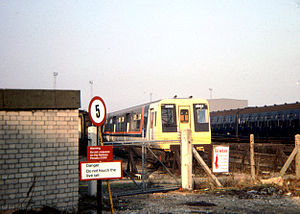The Southern Railway created classification and numbering systems for its large fleet of electric multiple units, perpetuated by the Southern Region of British Rail until the early 1980s, when the impact of TOPS was felt. Some stock is still allocated Southern-style classifications in a semi-official manner.

The British Rail Class 423, electric multiple unit passenger trains were mostly built by British Rail (BR) at York Works from 1967 to 1974, although the MBSOs and TSOs of the first 20, 7701-7720, were built at Derby Works. They have manually opening doors next to every seating row and were the last coaching stock built in this pattern for BR. They were mostly found working outer-suburban services in South London and rural services in Kent, Sussex and Hampshire, up to 2005 when they were finally replaced by Electrostar and Desiro units. The fleet had a working life of 38 years.

The British Rail Class 487 electric multiple units were built by English Electric in 1940, for use on the Waterloo & City line.

The Southern Railway (SR) gave the designation 2-BIL to the DC third rail electric multiple units built during the 1930s to work long-distance semi-fast services on the newly electrified lines from London to Eastbourne, Portsmouth and Reading. This type of unit survived long enough in British Rail ownership to be allocated TOPS Class 401.

The SR Class 4DD was an experimental double-decker electric multiple unit built in 1949 and operated by the Southern Railway until 1971. Conceived by Oliver Bulleid for the Southern Railway's commuter line from London Charing Cross to Dartford, the two trains were the only double-decker trains to be used on the mainline railway network in Britain. Whilst commonly used in continental Europe and North America, the restrictive railway loading gauge in the United Kingdom prohibits normal double-decker trains with two fully separated decks.
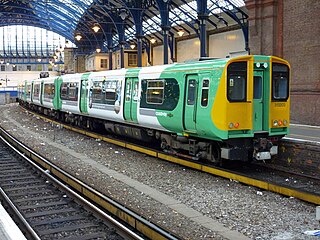
The British Rail Class 313 is a dual-voltage electric multiple unit (EMU) train built by British Rail Engineering Limited's Holgate Road carriage works between February 1976 and April 1977. They were the first production units that were derived from British Rail's 1971 prototype suburban EMU design which, as the BREL 1972 family, eventually encompassed 755 vehicles over five production classes. They were the first second-generation EMUs to be constructed for British Rail and the first British Rail units with both a pantograph for 25 kV 50 Hz AC overhead lines and contact shoe equipment for 750 V DC third rail supply. They were, additionally, the first units in Britain to employ multi-function automatic Tightlock couplers, which include electrical and pneumatic connections allowing the coupling and uncoupling of units to be performed unassisted by the driver whilst in the cab.
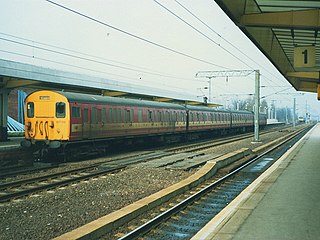
The British Rail Class 307 electric multiple units were built by BR at Eastleigh Works from 1954 to 1956. They were initially classified as AM7 before the introduction of TOPS.

The British Rail Class 201 six-car diesel-electric multiple units (DEMUs) were built in 1957–1958 at Eastleigh and underframes were built at Ashford.

The British Rail Class 504 was a unique type of electric multiple unit that ran on 1,200 V DC third rail with side-contact current collection. All other mainline UK third rails have the electric "shoe" on top of the rail. The type was used only on the Bury Line between Manchester and Bury. They were built in 1959 at Wolverton Works, and the body was a standard type used for several electrification schemes of the time, but the high DC voltage through a side-contact third rail was unique in Britain. The trains replaced the previous five-car units built by the Lancashire and Yorkshire Railway (LYR) for the route, which had inaugurated this electrification scheme in 1916.

An electric multiple unit (EMU) is an electric self-powered train, capable of operating in multiple with other EMUs and without the need for a locomotive; these are typically passenger trains with accommodation in every vehicle and a driving position at each end. The term can also be used to describe a train that is a permanent formation with a non-driving power car, such as the Advanced Passenger Train. As of December 2010, two-thirds of the passenger carriages in Great Britain are formed in EMUs.

The British Rail Class 501 electric multiple units were built in 1955/56 for use on the former LNWR/LMS suburban electric network of the London Midland Region. A total of 57 three-car units were built.

British Rail Class 503 passenger trains were 65 mph (105 km/h) electric multiple units. They were introduced in two batches. The first were in 1938, by the London, Midland and Scottish Railway (LMS) with a further batch in 1956 by the then nationalised British Railways (BR). When introduced by the LMS, they were officially known as Class AM3. They were designed for, and operated on, the Wirral & Mersey lines from Liverpool to West Kirby, New Brighton, and Rock Ferry. There were few places on their network of closely spaced stations to attain their maximum speed, except for the open section between Moreton and Meols. All but one set were withdrawn and scrapped by 1985. The final set was used on special Merseyrail services until 1988, and this preserved set was kept at the Electric Railway Museum near Coventry until moved to the Locomotive Storage Ltd warehouse at Margate.
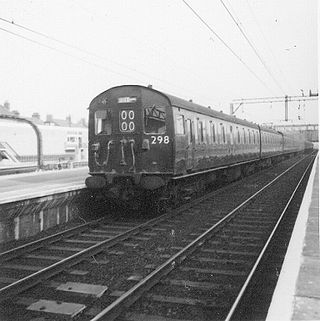
The British Rail Class 302 was a type of electric multiple unit (EMU) introduced between 1958 and 1960 for outer suburban passenger services on the London, Tilbury and Southend line. This class of multiple unit was constructed using the Mark 1 bodyshell and was slam-door.
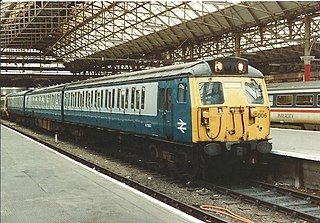
The British Rail Class 304 were AC electric multiple units designed and produced at British Rail's (BR) Wolverton Works.

The British Rail Class 305 was an alternating current (AC) electric multiple unit (EMU). Under the pre-1973 British Rail numbering system, the class was known as AM5. When TOPS was introduced, the class became Class 305.

The British Rail Class 502 was a type of electric multiple-unit passenger train, originally built by the London, Midland and Scottish Railway at its Derby Works. Introduced in 1940 and withdrawn by 1980, they spent the whole of their working lives on the electrified railway lines north of Liverpool.

The Tyne and Wear Metrocars are a fleet of light rail vehicles manufactured by Metro-Cammell for the Tyne and Wear Metro in North East England between 1978 and 1981. For operation on Network Rail controlled tracks between Pelaw Junction and Sunderland, they are designated on TOPS as the Class 599. Most were refurbished between 2010 and 2015 by Wabtec Rail at Doncaster Works and are scheduled to be replaced by Class 555 rolling stock from 2024.

Diesel multiple units and railcars are trains, usually with passenger accommodation, that do not require a locomotive. Railcars can be single cars, while in multiple units cars are marshalled together with a driving position either end. As of December 2010, 23 percent of the rail passenger cars used on Network Rail are part of a diesel multiple unit.

Network SouthEast (NSE), the sector of British Rail which ran passenger services in London and southeast England between 1986 and 1994, operated a wide variety of rolling stock during its existence. The majority of the network was electrified, and further electrification schemes took place during the 1986–1994 period; and the 7,000 vehicles owned by NSE in 1986 consisted of a mixture of electric, diesel-electric and diesel multiple units, diesel locomotives and the coaches they hauled.

The British Rail Class 316 was a proposed type of electric multiple unit intended for use on planned urban rail services in Greater Manchester. Intended as part of the family of EMUs descended from the prototype "PEP" stock, the class was never proceeded with as the planned services for which it was to be built were cancelled.
